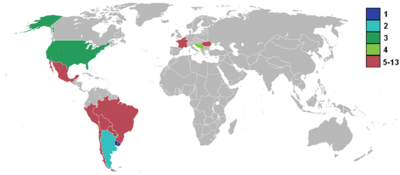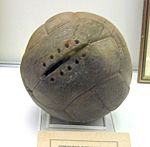1930 FIFA World Cup facts for kids
| 1er Campeonato Mundial de Fútbol (Spanish) | |
|---|---|
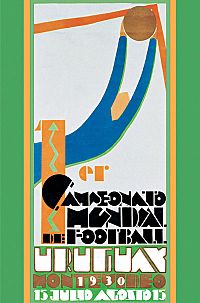
Official poster, designed
by Guillermo Laborde |
|
| Tournament details | |
| Host country | Uruguay |
| Dates | 13–30 July |
| Teams | 13 (from 3 confederations) |
| Venue(s) | 3 (in 1 host city) |
| Final positions | |
| Champions | |
| Runners-up | |
| Third place | |
| Fourth place | |
| Tournament statistics | |
| Matches played | 18 |
| Goals scored | 70 (3.89 per match) |
| Attendance | 590,549 (32,808 per match) |
| Top scorer(s) | (8 goals) |
The 1930 FIFA World Cup was the very first FIFA World Cup ever held. It was a big football tournament for national teams from around the world. The event took place in Uruguay from July 13 to July 30, 1930.
FIFA, the main group that runs international football, chose Uruguay to host the tournament. This was because Uruguay was celebrating 100 years since its first constitution. Also, the Uruguay national football team had won the football gold medal at the 1928 Summer Olympics. All the games were played in Uruguay's capital city, Montevideo. Most matches took place at the Estadio Centenario, a stadium built just for this special event.
Thirteen teams joined the tournament. Seven teams were from South America, four from Europe, and two from North America. Not many European teams came because it was a long and expensive trip across the ocean. This was also during a tough economic time called the Great Depression.
The teams were put into four groups. The winner of each group moved on to the semi-finals. The first two World Cup matches happened at the same time. France beat Mexico 4–1, and the United States beat Belgium 3–0. Lucien Laurent from France scored the very first goal in World Cup history. On the same day, United States goalkeeper Jimmy Douglas had the first "clean sheet" (meaning he didn't let any goals in).
Argentina, Uruguay, the United States, and Yugoslavia won their groups and went to the semi-finals. In the final match, host nation Uruguay beat Argentina 4–2. Over 68,000 people watched this exciting game. Uruguay became the first country to win the World Cup. Francisco Varallo from Argentina was the last player from this World Cup who was still alive. He passed away in 2010 at 100 years old. The 2030 FIFA World Cup will have its opening match at the Estadio Centenario to celebrate 100 years of the World Cup.
The 1930 World Cup final was the first and only time two Spanish-speaking teams played each other for the title. It was also the only time two South American teams played in the final.
Contents
How the World Cup Started
FIFA, the group that manages football around the world, had been thinking about creating a competition for national teams for many years. They had already managed the football part of the Summer Olympics since the early 1900s. The football events at the 1924 and 1928 Olympic Games were very successful. This success led to the idea of the FIFA World Cup.
At a FIFA meeting in Amsterdam in May 1928, FIFA president Jules Rimet suggested the competition. Everyone on the board agreed. Vice-president Henri Delaunay said that "international football can no longer be held within the confines of the Olympics." This meant football had grown too big for just the Olympics.
Teams That Joined
The first World Cup was the only one where teams didn't have to qualify. Every country that was part of FIFA was invited to play. They had until February 28, 1930, to say yes. The plan was for 16 teams, but not enough teams signed up.
Many countries from North and South America were interested. These included Argentina, Brazil, Bolivia, Chile, Mexico, Paraguay, Peru, and the United States. Seven South American teams played, which is more than in any World Cup since.
However, it was a very long and costly trip by ship across the Atlantic Ocean. Players also had to be away from their jobs for a long time. Because of this, and a worldwide economic problem called the Great Depression, very few European teams wanted to come. No European teams had signed up by the February deadline.
To try and get some European teams, the Uruguayan Football Association even invited England, Northern Ireland, Scotland, and Wales. But these British teams had left FIFA at the time, and they said no. Japan, Thailand, and Egypt were also invited. Egypt's team was delayed by a storm and missed the ship.
Two months before the tournament, no European team had officially entered. FIFA president Rimet stepped in. Finally, four European teams agreed to make the long sea journey: Belgium, France, Romania, and Yugoslavia.
- The Romanian team joined after their new King, King Carol II, helped out. He even chose the players himself and talked to their bosses to make sure they would still have jobs when they came back.
- France joined because President Rimet personally asked them.
- Belgium joined because a FIFA vice-president from Germany and Belgium, Rodolphe Seeldrayers, encouraged them.
We were 15 days on the ship Conte Verde getting out there. We embarked from Villefranche-sur-Mer in the company of the Belgians and the Yugoslavians. We did our basic exercises down below and our training on deck. The coach never spoke about tactics at all ...
The Romanian team got on the ship called the SS Conte Verde in Italy. The French and Yugoslav teams joined in France on June 21, 1930. The Belgian team got on in Spain. The Conte Verde also carried President Rimet, the World Cup trophy, and three referees from Europe. The Brazilian team joined the ship in Rio de Janeiro before it arrived in Uruguay on July 4.
List of Invited Teams
The following 14 teams planned to compete. However, only 13 teams played because Egypt missed the ship.
|
Stadiums and Locations
Italy, Sweden, the Netherlands, Spain, Hungary, and Uruguay all wanted to host the first World Cup. Uruguay's offer became the clear choice after all the other countries pulled out.
All the matches were played in Montevideo, the capital of Uruguay. Three stadiums were used: Estadio Centenario, Estadio Pocitos, and Estadio Gran Parque Central.
- The Estadio Centenario was built for the tournament and to celebrate 100 years of Uruguay's independence. It was the main stadium and was called a "temple of football" by FIFA President Rimet. It could hold 90,000 people, making it the biggest football stadium outside the British Isles at the time.
- The Centenario wasn't ready until five days into the tournament because of a rainy winter. So, the first few matches were played at smaller stadiums. These were the Estadio Gran Parque Central (capacity 20,000) and the Estadio Pocitos (capacity 10,000). These stadiums were usually used by local football clubs.
| Montevideo | ||
|---|---|---|
| Estadio Centenario | Estadio Gran Parque Central | Estadio Pocitos |
| 34°53′40″S 56°9′10″W / 34.89444°S 56.15278°W | 34°54′4″S 56°9′32″W / 34.90111°S 56.15889°W | 34°54′18″S 56°9′22″W / 34.90500°S 56.15611°W |
| Capacity: 90,000 | Capacity: 20,000 | Capacity: 10,000 |
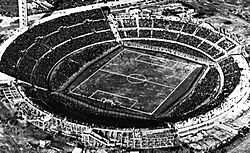 |
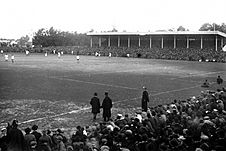 |
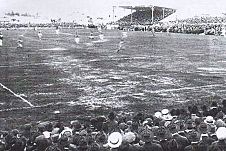 |
Referees and Officials
Fifteen referees worked at the tournament. Four were from Europe and eleven were from North and South America. To make sure everyone understood the rules the same way, the referees had a short meeting.
Two referee decisions caused a lot of talk:
- In the match between Argentina and France, the Brazilian referee Gilberto de Almeida Rêgo blew the final whistle six minutes too early.
- In the Argentina and Mexico game, the Bolivian referee Ulises Saucedo (who was also Bolivia's coach) gave three penalty kicks.
The following people served as referees and linesmen:
|
|
Tournament Format
The 13 teams were divided into four groups. Group 1 had four teams, and the others had three. Each group played a round-robin style, meaning every team in the group played each other once. The four teams that won their groups moved on to the semi-finals.
Uruguay, Argentina, Brazil, and the United States were "seeded" teams. This meant they were kept apart in the draw so they wouldn't play each other too early. The draw happened in Montevideo after all the teams arrived.
Since there were no qualifying games, the first two matches of the tournament were the first World Cup games ever played. They happened at the same time on July 13, 1930. France beat Mexico 4–1, and the United States beat Belgium 3–0. France's Lucien Laurent scored the first World Cup goal.
Summary of the Games
Group 1 Matches
We were playing Mexico and it was snowing, since it was winter in the southern hemisphere. One of my teammates centred the ball and I followed its path carefully, taking it on the volley with my right foot. Everyone was pleased but we didn't all roll around on the ground – nobody realised that history was being made. A quick handshake and we got on with the game. And no bonus either; we were all amateurs in those days, right to the end.
Group 1 had Argentina, Chile, France, and Mexico. Two days after France's win over Mexico, they played Argentina. France had some injured players. Their goalkeeper Alex Thépot had to leave the game, and Laurent was limping. But they played well for most of the match. Argentina finally scored in the 81st minute from a Luis Monti free kick. There was a mix-up when the referee blew the whistle six minutes too early, but play started again.
Chile beat Mexico 3–0. In France's last match against Chile, the first penalty kick of the World Cup happened. Thépot of France saved it. In Argentina's game against Mexico, three penalty kicks were given. Guillermo Stábile scored three goals (a hat-trick) in his first international game, and Argentina won 6–3. Argentina beat Chile 3–1 in the final group match and moved to the semi-finals.
Group 2 Matches
Group 2 included Brazil, Bolivia, and Yugoslavia. Many expected Brazil to win the group. But in the first match, Yugoslavia surprisingly beat Brazil 2–1. Bolivia had never won an international match before. For their first game, they wore shirts that spelled "Viva Uruguay" to honor the hosts. Bolivia lost both their matches. Yugoslavia qualified for the semi-finals.
Group 3 Matches
Host nation Uruguay was in a group with Peru and Romania. In the first game of this group, Plácido Galindo of Peru was sent off, becoming the first player to be expelled from a World Cup match. Romania won 3–1. This match had the smallest crowd in World Cup history, with only about 300 people watching.
Uruguay's first match was delayed because the Estadio Centenario wasn't ready. When it finally happened, it was a big celebration for Uruguay's 100th anniversary. The Uruguayan team had been training very strictly. Their goalkeeper Andrés Mazali was even removed from the team for breaking a curfew. Uruguay won a close match against Peru. Later, Uruguay easily beat Romania 4–0.
Group 4 Matches
Group 4 had Belgium, Paraguay, and the United States. The American team, sometimes called "the shot-putters," beat Belgium 3–0. The game was tough due to heavy rain and snow. The United States then played Paraguay. Bert Patenaude of the United States scored the first tournament hat-trick in this game. For a long time, FIFA thought another player scored the first hat-trick, but in 2006, they confirmed Patenaude's record. The United States won the group and moved on. Paraguay beat Belgium 1–0 in their final match.
Semi-finals
The four group winners—Argentina, Yugoslavia, Uruguay, and the United States—went to the semi-finals. Both semi-final matches ended with the same score: 6–1.
- In the first semi-final, the United States played Argentina on a very wet field. The game became rough, and a U.S. player, Raphael Tracey, broke his leg. Argentina won 6–1.
- In the second semi-final, Yugoslavia took an early lead against Uruguay. But Uruguay came back and scored. Yugoslavia had a goal disallowed for offside, which was a controversial decision. Uruguay then scored three more goals to win 6–1. Pedro Cea scored three goals for Uruguay.
Third and Fourth Place
The idea of a "third-place play-off" game wasn't common until the 1934 World Cup. So, the 1930 World Cup didn't have a specific match to decide third and fourth place. Some reports say Yugoslavia refused to play a third-place match because they were unhappy with the refereeing in their semi-final against Uruguay.
At the end of the tournament, the captains of the United States team (Tom Florie) and Yugoslavia (Milutin Ivković) both received bronze medals. FIFA later officially ranked the United States as third and Yugoslavia as fourth, based on their overall results.
The Final Match
The final was a rematch of the 1928 Olympic final, which Uruguay had won. The final was played at the Estadio Centenario on July 30. Many Argentine fans tried to cross the river to Montevideo, but the port was so busy that many couldn't even get to the stadium. About 10,000 to 15,000 Argentinians made the trip.
At the stadium, fans were searched for weapons. The gates opened six hours before the game, and by noon, the stadium was full with 93,000 people. There was a disagreement before the match about which team's football should be used. FIFA decided that Argentina would provide the ball for the first half, and Uruguay would provide their own for the second half.
Uruguay scored the first goal through Pablo Dorado. Argentina quickly responded and Carlos Peucelle equalized. Just before half-time, Guillermo Stábile gave Argentina a 2–1 lead. Uruguay's captain protested, saying Stábile was offside, but the goal stood.
In the second half, Uruguay played much better. Pedro Cea scored to make it 2–2. Ten minutes later, Santos Iriarte gave Uruguay the lead. Just before the end of the game, Héctor Castro scored to make it 4–2, sealing the win for Uruguay. The referee ended the match a minute later.
Jules Rimet presented the World Cup Trophy (which was later named after him) to the head of the Uruguayan Football Association. The next day was a national holiday in Uruguay. In Argentina's capital, Buenos Aires, people threw stones at the Uruguayan consulate. Francisco Varallo, an Argentine player, was the last player from this final to pass away, on August 30, 2010.
Uruguay's total goal difference of +12 over four games is still the highest average goal difference per match for any World Cup champion.
Group Stage Results
Group 1
1930 FIFA World Cup Group 1 1930 FIFA World Cup Group 1
1930 FIFA World Cup Group 1
1930 FIFA World Cup Group 1
1930 FIFA World Cup Group 1
1930 FIFA World Cup Group 1
1930 FIFA World Cup Group 1
Group 2
1930 FIFA World Cup Group 2 1930 FIFA World Cup Group 2
1930 FIFA World Cup Group 2
1930 FIFA World Cup Group 2
Group 3
1930 FIFA World Cup Group 3 1930 FIFA World Cup Group 3
1930 FIFA World Cup Group 3
1930 FIFA World Cup Group 3
Group 4
1930 FIFA World Cup Group 4 1930 FIFA World Cup Group 4
1930 FIFA World Cup Group 4
1930 FIFA World Cup Group 4
Knockout Stage
Bracket
1930 FIFA World Cup knockout stage
Semi-finals
1930 FIFA World Cup knockout stage
1930 FIFA World Cup knockout stage
Final
1930 FIFA World Cup final
Top Goalscorers
There were 70 goals scored in 18 matches, for an average of 3.89 goals per match.
8 goals
5 goals
4 goals
3 goals
 Carlos Peucelle
Carlos Peucelle Preguinho
Preguinho Peregrino Anselmo
Peregrino Anselmo Ivan Bek
Ivan Bek
2 goals
 Luis Monti
Luis Monti Adolfo Zumelzú
Adolfo Zumelzú Moderato
Moderato Guillermo Subiabre
Guillermo Subiabre Carlos Vidal
Carlos Vidal André Maschinot
André Maschinot Manuel Rosas
Manuel Rosas Héctor Castro
Héctor Castro Pablo Dorado
Pablo Dorado Santos Iriarte
Santos Iriarte Đorđe Vujadinović
Đorđe Vujadinović
1 goal
 Mario Evaristo
Mario Evaristo Alejandro Scopelli
Alejandro Scopelli Francisco Varallo
Francisco Varallo Marcel Langiller
Marcel Langiller Lucien Laurent
Lucien Laurent Juan Carreño
Juan Carreño Roberto Gayón
Roberto Gayón Luis Vargas Peña
Luis Vargas Peña Luis de Souza
Luis de Souza Adalbert Deșu
Adalbert Deșu Nicolae Kovács
Nicolae Kovács Constantin Stanciu
Constantin Stanciu Jim Brown
Jim Brown Tom Florie
Tom Florie Bart McGhee
Bart McGhee Héctor Scarone
Héctor Scarone Blagoje Marjanović
Blagoje Marjanović Aleksandar Tirnanić
Aleksandar Tirnanić
1 own goal
 Manuel Rosas (against Chile)
Manuel Rosas (against Chile)
Source=
FIFA Rankings
In 1986, FIFA released a report that ranked all teams from past World Cups. This ranking was based on how far teams went in the competition, their overall results, and the quality of the teams they played against. Here are the rankings for the 1930 tournament:
| R | Team | G | P | W | D | L | GF | GA | GD | Pts |
|---|---|---|---|---|---|---|---|---|---|---|
| 1 | 3 | 4 | 4 | 0 | 0 | 15 | 3 | +12 | 8 | |
| 2 | 1 | 5 | 4 | 0 | 1 | 18 | 9 | +9 | 8 | |
| 3 | 4 | 3 | 2 | 0 | 1 | 7 | 6 | +1 | 4 | |
| 4 | 2 | 3 | 2 | 0 | 1 | 7 | 7 | 0 | 4 | |
| Eliminated in the group stage | ||||||||||
| 5 | 1 | 3 | 2 | 0 | 1 | 5 | 3 | +2 | 4 | |
| 6 | 2 | 2 | 1 | 0 | 1 | 5 | 2 | +3 | 2 | |
| 7 | 1 | 3 | 1 | 0 | 2 | 4 | 3 | +1 | 2 | |
| 8 | 3 | 2 | 1 | 0 | 1 | 3 | 5 | −2 | 2 | |
| 9 | 4 | 2 | 1 | 0 | 1 | 1 | 3 | −2 | 2 | |
| 10 | 3 | 2 | 0 | 0 | 2 | 1 | 4 | −3 | 0 | |
| 11 | 4 | 2 | 0 | 0 | 2 | 0 | 4 | −4 | 0 | |
| 12 | 2 | 2 | 0 | 0 | 2 | 0 | 8 | −8 | 0 | |
| 13 | 1 | 3 | 0 | 0 | 3 | 4 | 13 | −9 | 0 | |
Images for kids
See also
 In Spanish: Copa Mundial de Fútbol de 1930 para niños
In Spanish: Copa Mundial de Fútbol de 1930 para niños


